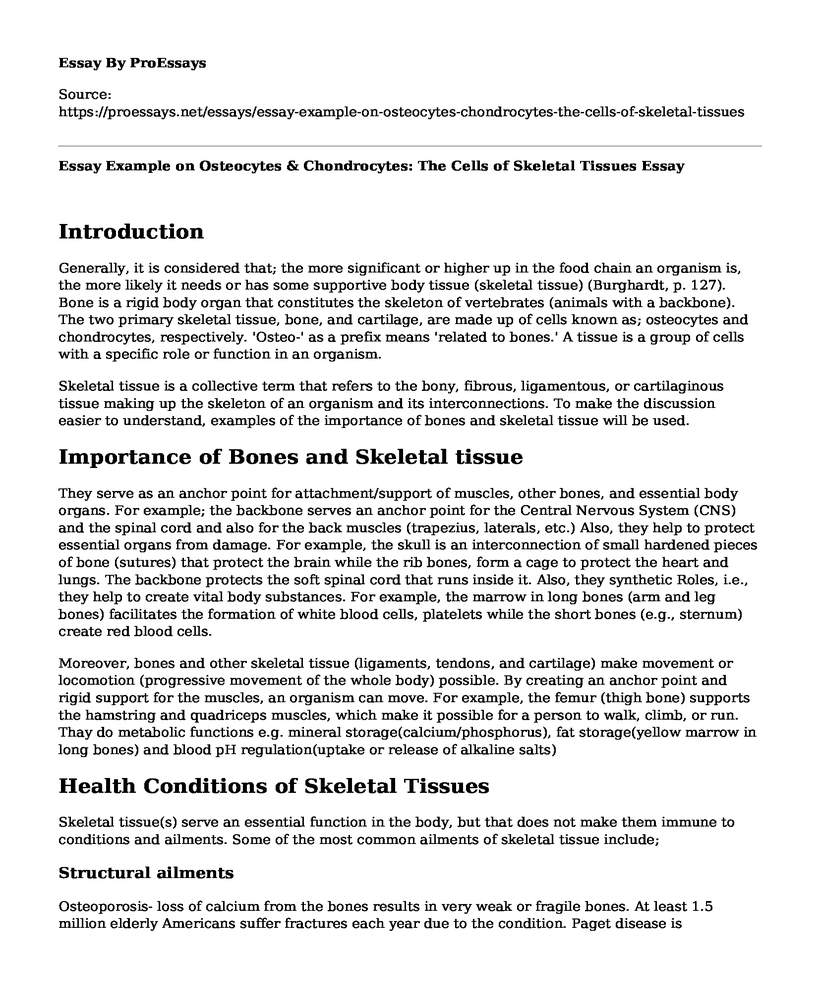Introduction
Generally, it is considered that; the more significant or higher up in the food chain an organism is, the more likely it needs or has some supportive body tissue (skeletal tissue) (Burghardt, p. 127). Bone is a rigid body organ that constitutes the skeleton of vertebrates (animals with a backbone). The two primary skeletal tissue, bone, and cartilage, are made up of cells known as; osteocytes and chondrocytes, respectively. 'Osteo-' as a prefix means 'related to bones.' A tissue is a group of cells with a specific role or function in an organism.
Skeletal tissue is a collective term that refers to the bony, fibrous, ligamentous, or cartilaginous tissue making up the skeleton of an organism and its interconnections. To make the discussion easier to understand, examples of the importance of bones and skeletal tissue will be used.
Importance of Bones and Skeletal tissue
They serve as an anchor point for attachment/support of muscles, other bones, and essential body organs. For example; the backbone serves an anchor point for the Central Nervous System (CNS) and the spinal cord and also for the back muscles (trapezius, laterals, etc.) Also, they help to protect essential organs from damage. For example, the skull is an interconnection of small hardened pieces of bone (sutures) that protect the brain while the rib bones, form a cage to protect the heart and lungs. The backbone protects the soft spinal cord that runs inside it. Also, they synthetic Roles, i.e., they help to create vital body substances. For example, the marrow in long bones (arm and leg bones) facilitates the formation of white blood cells, platelets while the short bones (e.g., sternum) create red blood cells.
Moreover, bones and other skeletal tissue (ligaments, tendons, and cartilage) make movement or locomotion (progressive movement of the whole body) possible. By creating an anchor point and rigid support for the muscles, an organism can move. For example, the femur (thigh bone) supports the hamstring and quadriceps muscles, which make it possible for a person to walk, climb, or run. Thay do metabolic functions e.g. mineral storage(calcium/phosphorus), fat storage(yellow marrow in long bones) and blood pH regulation(uptake or release of alkaline salts)
Health Conditions of Skeletal Tissues
Skeletal tissue(s) serve an essential function in the body, but that does not make them immune to conditions and ailments. Some of the most common ailments of skeletal tissue include;
Structural ailments
Osteoporosis- loss of calcium from the bones results in very weak or fragile bones. At least 1.5 million elderly Americans suffer fractures each year due to the condition. Paget disease is characterized by unusually thick but fragile bones due to abnormal structure. Others include; Osteomalacia (Rickets) due to vitamin D deficiency and Scoliosis (abnormal curvature of the spine). Remedies include; supplements (calcium), Proper Nutrition, regular exercise, and corrective surgery for the latter.
Infectious ailments
Osteomyelitis (bone infection) and septic arthritis (joint infection caused by bacteria virus or fungi). They may come as opportunistic infections of; Lyme disease or Hepatitis. Remedies are; use of drugs (antibiotics) and healthy diet and lifestyle.
Joint ailments
Osteoarthritis- joint cartilage wear and tear, which causes pain and stiffness at the joints. Often seen in old people (those over 50). Other forms are; rheumatoid arthritis (immune system gets a false alarm and attacks the joint tissue) and gout (sand-like deposits in joints). They are treated by taking prescribed medication, dietary supplements, foods rich in calcium, and active lifestyle. (Foreseen, p. 38, 39)
Tumors
The tumors or abnormal growths can be both cancerous or not. The most common forms are 'metastatic,' i.e., they spread from infected organs (lungs, colon) to the bones. Cancer that originates directly from bones is rare. The most common form of Bone Cancer is Osteosarcoma, which affects the long bones (arm and leg). Non-cancerous growths are most frequently seen in children and young adults. Remedies include; preventive measures (proper nutrition, healthy lifestyle) and surgery or chemotherapy.
Conclusion
Skeletal tissue plays such an important role in the body. It is not possible to include all there is to know about them in this one study. It is safe to say that health or illness is a choice. Of course, some happen by misfortune (hereditary/genetic factors) but notice the word I used, Lifestyle, which means it is about making a choice. Most of them emanate from a poor lifestyle. No wonder the name, Lifestyle Diseases.
Works Cited
Burghardt, Tillman, et al. "The interaction of Nanoarchaeum equitans with Ignicoccus hospitalis: proteins in the contact site between two cells." (2009): 127-132.
Borresen, Jill. "Highly recommended: an active lifestyle." Plus 50 13.4 (2018): 38-39.
Smith, Felisa A., et al. "Megafauna in the Earth system." Ecography 39.2 (2016): 99-108.
Cite this page
Essay Example on Osteocytes & Chondrocytes: The Cells of Skeletal Tissues. (2023, May 03). Retrieved from https://proessays.net/essays/essay-example-on-osteocytes-chondrocytes-the-cells-of-skeletal-tissues
If you are the original author of this essay and no longer wish to have it published on the ProEssays website, please click below to request its removal:
- An Analysis of a Research Paper: Masculinity and the Persistence of AIDS Stigma
- Medicine Essay on Cataract Disease
- Essay on Christian View of Euthanasia
- Essay Example on Diabetes: Examining Its Impact on Health and Well-Being
- Is Abortion Legally & Morally Permissible? - Research Paper
- Essay Example on Organization Development: WHO, Ideas, and Employee Rewards
- COVID-19: Public Health Measures for Delaying Community Transmission - Research Paper







